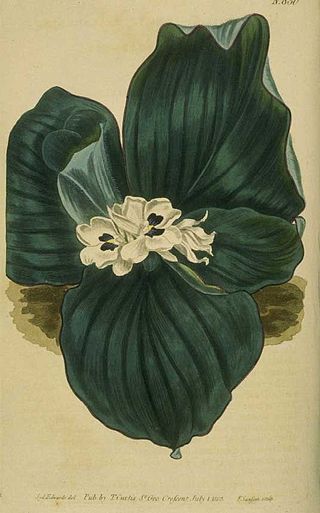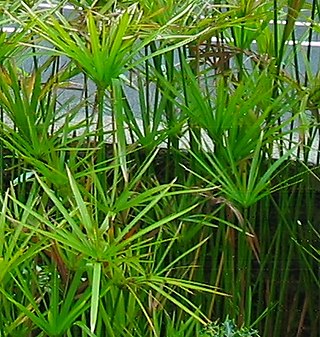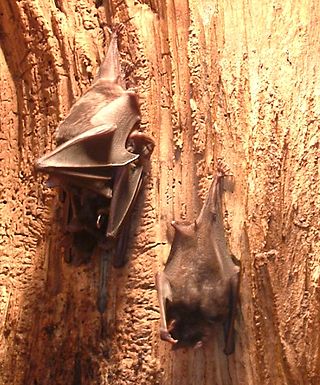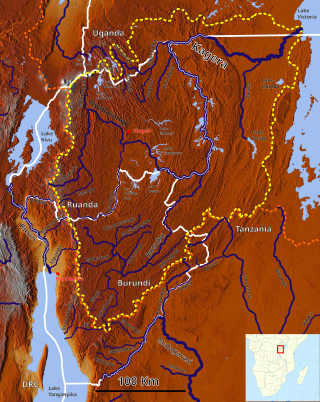
Podocarpus latifolius is a large evergreen tree up to 35 m high and 3 m trunk diameter, in the conifer family Podocarpaceae; it is the type species of the genus Podocarpus.

Galangal is a common name for several tropical rhizomatous spices.

Cyperus papyrus, better known by the common names papyrus, papyrus sedge, paper reed, Indian matting plant, or Nile grass, is a species of aquatic flowering plant belonging to the sedge family Cyperaceae. It is a tender herbaceous perennial, native to Africa, and forms tall stands of reed-like swamp vegetation in shallow water.

The Cyperaceae are a family of graminoid (grass-like), monocotyledonous flowering plants known as sedges. The family is large, with some 5,500 known species described in about 90 genera, the largest being the "true sedges" genus Carex with over 2,000 species.

Lathyrus latifolius, the perennial peavine, perennial pea, broad-leaved everlasting-pea, or just everlasting pea, is a robust, sprawling herbaceous perennial flowering plant in the pea family Fabaceae. It is native to Europe but is present on other continents, such as North America and Australia, where it is most often seen along roadsides.

Cyperus is a large genus of about 700 species of sedges, distributed throughout all continents in both tropical and temperate regions.

Cyperus rotundus is a species of sedge (Cyperaceae) native to Africa, southern and central Europe, and southern Asia. The word cyperus derives from the Greek κύπερος, kyperos, and rotundus is from Latin, meaning "round". The earliest attested form of the word cyperus is the Mycenaean Greek 𐀓𐀞𐀫, ku-pa-ro, written in Linear B syllabic script.

Cyperus alternifolius, the umbrella papyrus, umbrella sedge or umbrella palm, is a grass-like plant in the large genus Cyperus of the sedge family Cyperaceae. The plant is native to West Africa, Madagascar and the Arabian Peninsula, but widely distributed throughout the world. It has gained the Royal Horticultural Society's Award of Garden Merit. The subspecies Cyperus alternifolius ssp. flabelliformis is also known as Cyperus involucratusRottb..

The Guianan spear-nosed bat is a bat species found in Brazil, Colombia, Guyana, Suriname and Venezuela.

Phyllostomus is a genus of leaf-nosed bat. It contains four described species.

Cyperus eragrostis is a species of sedge known by several common names, including tall flatsedge, nutgrass, tall nutgrass, umbrella sedge, chufa, Earth almond, zula nuts, edible galingale and pale galingale.

Cyperus fuscus is a species of sedge known by the common name brown galingale, or brown flatsedge. This plant is native to much of Europe, Asia and North Africa from England, Portugal and Morocco east to China and Thailand. It is an introduced species in North America, where it is naturalized in widely scattered locations in the United States and Canada.

Cyperus scariosus is a perennial herbaceous plant from Australia and New Guinea.

Cyperus laevigatus is a species of sedge known by the common name smooth flatsedge.
The Rugezi Marsh is a protected area in Rwanda, covering 6,735 hectares. The wetland is one of headwaters of the Nile, situated in the Northern Province within the Buberuka Highlands. At 2,100 metres (6,900 ft), the marsh is a high altitude peat bog. Rugezi developed from an accumulation of organic materials within a quartzite rock-trapping water depression. In its natural state, Rugezi has been playing a significant ecological, hydrological, socio-economical, historic, and recreational role in Rwanda. It is also an Important Bird Area (IBA) recognized by the BirdLife International in 2001, and is reported to be the habitat of 43 species of birds within and in the surrounding areas of the marsh; the area of IBA is identified as ha8,500 hectares. The specific species of Grauer's swamp warbler and white-winged swamp warbler living together is reported as "unusual" by BirdLife International.

Isopogon latifolius is a shrub of the family Proteaceae that is endemic to the southwest botanical province of Western Australia.

The Akanyaru River is the main tributary of the Nyabarongo River. It rises in the western highlands of Rwanda and Burundi, flows east and then north along the border between those countries before joining the Nyabarongo River. The lower stretches contain important but unprotected wetlands, which are under threat from human activity.

Cyperus compressus, commonly known as annual sedge, is a sedge of the family Cyperaceae that has a wide distribution throughout countries with warmer climates. It is found in tropical areas of Africa, Asia and the Americas.
















